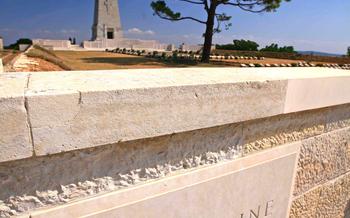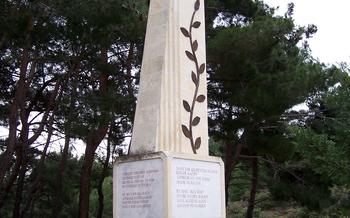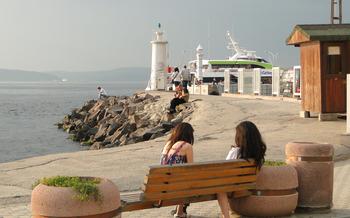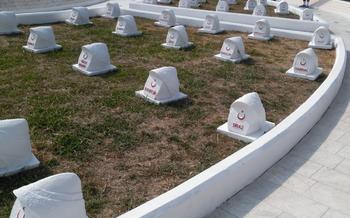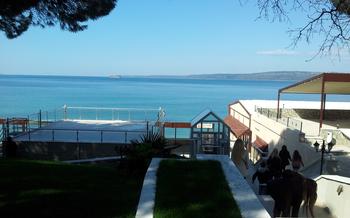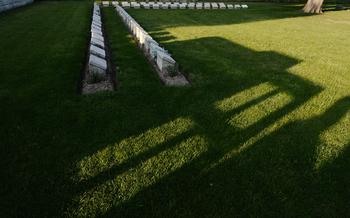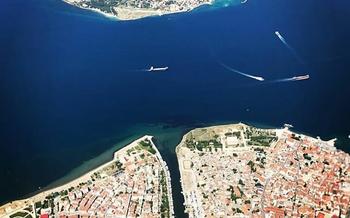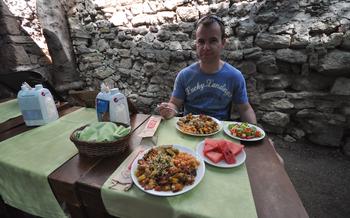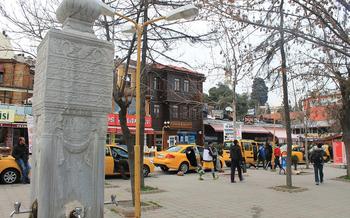
The Helles Memorial
- The Helles Memorial: A Majestic Tribute to Fallen Heroes
- Location and Accessibility
- Exploring the Memorial Grounds
- The Lone Pine Cemetery
- The Anzac Commemorative Site
- The Turkish Memorial
- The Respectful Approach
- Nearby Points of Interest
- Planning Your Visit
- The Legacy of the Gallipoli Campaign
- Personal Stories and Anecdotes
- Educational Resources and Exhibitions
- Insider Tip: A Moment of Reflection
The Helles Memorial: A Majestic Tribute to Fallen Heroes
The Helles Memorial stands as an enduring tribute to the brave soldiers who lost their lives during the Gallipoli Campaign of World War I. Erected by the Commonwealth War Graves Commission, this poignant memorial commemorates the sacrifices made by Allied servicemen from Britain, Australia, New Zealand, India, and France.
Historical Significance: The Gallipoli Campaign, launched in April 1915, was a significant military campaign that aimed to capture the Gallipoli Peninsula and secure control of the Dardanelles Strait. The campaign, however, turned into a costly and protracted battle, resulting in heavy casualties on both sides. The Helles Memorial honors the memory of the over 20,000 Allied soldiers who perished during the campaign.
Architectural Features: Designed by Sir Edwin Lutyens, the renowned British architect, the Helles Memorial is an architectural masterpiece that blends classical and modern elements. The memorial features a grand colonnade of Ionic columns, surmounted by a frieze depicting scenes of battle and sacrifice. At the center stands a poignant bronze statue, known as the "Lone Pine Memorial," representing a weary soldier gazing out over the battlefield.
Commemoration Ceremonies: Each year, on the anniversary of the Gallipoli landings, a moving commemoration ceremony is held at the Helles Memorial. Representatives from the Commonwealth nations, descendants of the fallen soldiers, and international dignitaries gather to pay their respects and honor the sacrifices made during the campaign.
Emotional Impact of Visiting the Memorial: Visiting the Helles Memorial is a profoundly moving experience that evokes a range of emotions. The serene atmosphere, the poignant inscriptions, and the sheer scale of the memorial create a palpable sense of reverence and remembrance. As you walk among the graves and read the names of the fallen, you cannot help but be overwhelmed by a deep sense of gratitude and respect for their sacrifice.
Location and Accessibility
The Helles Memorial is situated on the Gallipoli Peninsula, in the province of Çanakkale, Turkey. Its exact address is "Helles Memorial, Morto Bay, Gallipoli Peninsula."
Getting There by Public Transportation:
From Istanbul, you can take a bus to Çanakkale (approximately 6 hours) and then a ferry to Eceabat (1 hour). From Eceabat, you can take a taxi or minibus to the memorial (about 15 minutes).
Driving Directions:
If driving from Istanbul, follow the E80 highway to Çanakkale. After crossing the 1915 Çanakkale Bridge, continue towards Eceabat. Once in Eceabat, follow the signs to the Gallipoli Peninsula National Park and the Helles Memorial.
Parking Availability:
There is ample free parking available at the memorial site.
Exploring the Memorial Grounds
The Helles Memorial stands as a solemn and evocative tribute to the fallen heroes of the Gallipoli Campaign. Its sprawling grounds offer a profound and immersive experience for visitors to delve into the history and significance of this pivotal battle.
Layout of the Memorial: The memorial complex is meticulously designed, with distinct sections dedicated to commemorating the fallen soldiers from different nations. The layout allows visitors to explore each area at their own pace, immersing themselves in the stories and sacrifices of those who fought here.
Notable Features and Monuments: Among the notable features of the memorial are the towering obelisk, which serves as the centerpiece of the site, and the impressive colonnades that flank the main courtyard. The names of the fallen are inscribed on these structures, ensuring that their memory lives on.
Wartime Artifacts and Exhibits: The memorial also houses a collection of poignant wartime artifacts and exhibits that provide a glimpse into the harsh realities of the Gallipoli Campaign. These include personal items belonging to the soldiers, such as letters, photographs, and equipment, as well as historical documents and maps that shed light on the course of the battles.
Orientation Maps and Brochures: To enhance the visitor experience, the memorial provides orientation maps and brochures that offer a comprehensive overview of the site. These resources guide visitors through the grounds, ensuring that they don't miss any of the significant monuments and features.
The Lone Pine Cemetery
The Lone Pine Cemetery stands as a solemn and poignant tribute to the brave soldiers who fought and fell during the fierce battles of Gallipoli. Located adjacent to the Helles Memorial, this hallowed ground is the final resting place for over 12,000 Australian and New Zealand soldiers who lost their lives in the conflict.
Maintained with meticulous care, the cemetery features immaculately aligned rows of white headstones, each bearing the name, rank, and unit of the fallen soldier. Among these graves, several notable memorials and monuments commemorate the sacrifices of specific individuals or units.
The Lone Pine Memorial, the centerpiece of the cemetery, honors the soldiers of the 1st Australian Imperial Force who fought and died in the Lone Pine trenches. The memorial bears the names of over 2,000 soldiers who have no known grave.
Another poignant memorial within the cemetery is the Turkish Lone Pine Memorial, which commemorates the Turkish soldiers who fought and died during the Gallipoli Campaign. This memorial serves as a reminder of the shared sacrifices made by both sides during the conflict.
The Lone Pine Cemetery offers visitors a profound opportunity to reflect on the human cost of war and to pay their respects to the young men who made the ultimate sacrifice. As you walk among the graves, take a moment to contemplate the stories of courage, camaraderie, and sacrifice that lie beneath these hallowed grounds.
The Anzac Commemorative Site
The Anzac Commemorative Site within the Helles Memorial complex holds immense significance for visitors from Australia and New Zealand. It serves as a poignant tribute to the brave ANZAC (Australian and New Zealand Army Corps) soldiers who fought and fell during the Gallipoli Campaign.
Interactive Displays and Exhibits The site captivates visitors with its immersive interactive displays and exhibits that bring the history of the campaign to life. Through multimedia presentations, artifacts, and personal accounts, visitors gain a deeper understanding of the challenges, sacrifices, and camaraderie experienced by the ANZAC troops.
Commemorative Services The Anzac Commemorative Site is a focal point for commemorative services held annually on ANZAC Day (April 25th). These ceremonies honor the memory of the fallen and celebrate the enduring spirit of the ANZAC legacy. The services feature wreath-laying, speeches, and heartfelt tributes, attracting a large gathering of descendants, dignitaries, and visitors from around the world.
Personal Stories and Anecdotes The site also features a collection of personal stories and anecdotes from ANZAC soldiers and their families. These poignant narratives offer a glimpse into the lives of the men who fought in the campaign, their motivations, fears, and hopes. Visitors are moved by the individual stories of courage, resilience, and sacrifice, gaining a deeper appreciation for the human dimension of the war.
The Turkish Memorial
Within the sprawling expanse of the Helles Memorial, a poignant tribute stands in remembrance of the Turkish soldiers who valiantly defended their homeland during the Gallipoli Campaign. Situated in a serene corner of the memorial complex, the Turkish Memorial exudes a profound aura of respect and solemnity. Its design, imbued with symbolic elements, evokes the memory of the fallen heroes who fought with unwavering courage and devotion.
The memorial features an impressive stone obelisk, its towering presence symbolizing the resilience and fortitude of the Turkish nation. The obelisk is adorned with intricate carvings and inscriptions that pay homage to the sacrifices made by the Turkish soldiers. Surrounding the obelisk is a meticulously landscaped garden, a tranquil oasis that invites visitors to pause and reflect upon the immense loss suffered during the conflict.
The Turkish Memorial serves as a poignant reminder of the shared sacrifices and common humanity that transcend the boundaries of nationality. It is a testament to the profound respect and reconciliation that have emerged in the years since the Gallipoli Campaign. Visitors from around the world stand in solidarity, honoring the memory of all those who fought and perished in this tragic conflict.
The Respectful Approach
The Helles Memorial is a sacred space dedicated to honoring the fallen soldiers of the Gallipoli Campaign. As visitors, it is essential to approach the memorial with utmost respect and sensitivity. Proper etiquette and behavior are crucial to maintaining the solemn atmosphere of the site.
Dress code and conduct: Visitors should dress appropriately, avoiding revealing or casual clothing. Respectful conduct is expected, with minimal talking and noise to ensure a peaceful environment.
Avoiding disturbances and distractions: The memorial grounds are not a place for recreational activities or loud conversations. Visitors should refrain from using mobile phones or engaging in disruptive behavior that may disturb the tranquility of the site.
Honoring the memory of the fallen: The memorial is a place of remembrance and reflection. Visitors are encouraged to take time to pause and contemplate the sacrifices made by the soldiers who fought and died in the Gallipoli Campaign. Laying flowers or wreaths at the graves or memorials is a common way to pay respects and honor their memory.
Nearby Points of Interest
The Helles Memorial is situated amidst a wealth of historical and natural attractions that invite further exploration. The Gallipoli Peninsula National Park, encompassing the wider battlefield area, offers visitors an immersive journey through the landscapes that witnessed the horrors of war. Within the park, you can discover numerous other memorials and cemeteries dedicated to the fallen soldiers of both sides.
Historical sites and museums in the vicinity provide deeper insights into the Gallipoli Campaign. The Gallipoli Museum in Çanakkale showcases artifacts, documents, and personal accounts that bring the historical events to life. The 57th Regiment Memorial commemorates the valiant efforts of the Turkish infantry during the fierce battle for Chunuk Bair.
Beyond the historical sites, the Gallipoli Peninsula boasts natural attractions and beaches that offer a serene contrast to the somber memorials. The pristine turquoise waters of Sarımsaklı Beach invite visitors to relax and soak up the sun. Gökçeada, the largest island in the Aegean Sea, lies just off the coast and offers a peaceful retreat with its lush forests and charming villages.
Whether you seek to delve deeper into the history of the Gallipoli Campaign or simply appreciate the natural beauty of the region, the surroundings of the Helles Memorial offer a multitude of enriching experiences.
Planning Your Visit
Visiting the Helles Memorial is a solemn and meaningful experience that requires careful planning. To make the most of your visit, consider the following factors:
-
Ideal Time to Visit: The best time to visit the memorial is during the spring or fall when the weather is mild and pleasant. The summer months can be hot and crowded, while the winter months can be cold and rainy.
-
Weather Conditions and Seasonal Variations: Be prepared for a variety of weather conditions, as the climate in Çanakkale can be unpredictable. Bring layers of clothing to accommodate changing temperatures, and consider packing waterproof gear in case of rain.
-
Accommodation Options in the Area: There are several accommodation options available in the vicinity of the memorial, ranging from budget-friendly hostels to comfortable hotels. Pre-booking your accommodation is recommended, especially during peak tourist seasons.
-
Packing Essentials and Travel Tips: When packing for your visit, remember to bring comfortable walking shoes, a hat or scarf to protect yourself from the sun or cold, and a water bottle to stay hydrated. Consider bringing a camera to capture the poignant beauty of the memorial and its surroundings.
The Legacy of the Gallipoli Campaign
The Gallipoli Campaign, despite its ultimate failure, left a profound and enduring legacy that continues to resonate in various ways:
-
Impact on World War I: The campaign marked a turning point in World War I, demonstrating the limits of Allied military power and the resilience of the Turkish forces. It also highlighted the strategic importance of the Dardanelles Strait and contributed to the broader Allied strategy of opening a new front in the war.
-
Significance for Australia and New Zealand: The campaign holds immense historical significance for Australia and New Zealand, as it was the first major military engagement for both nations. The heavy losses suffered during the campaign shaped their national identities and fostered a deep sense of patriotism and remembrance.
-
Commemorative events and anniversaries: The Gallipoli Campaign is commemorated annually in both Australia and New Zealand on ANZAC Day (April 25), a day of remembrance for all those who served and died in wars, conflicts, and peacekeeping operations. Commemorative services, parades, and wreath-laying ceremonies are held at war memorials and cemeteries across the two countries.
-
Ongoing historical research and remembrance: The Gallipoli Campaign remains a subject of ongoing historical research and remembrance. Scholars, historians, and researchers continue to study the campaign's military strategies, political implications, and the experiences of the soldiers who fought there. This ongoing research contributes to a deeper understanding of the campaign and its lasting impact.
Personal Stories and Anecdotes
The Helles Memorial is not just a monument in stone; it is a place where personal stories and anecdotes intertwine, creating a tapestry of sacrifice and remembrance. Soldiers' letters and diaries, often poignant and heart-wrenching, offer a glimpse into the lives and emotions of those who fought and fell at Gallipoli. Eyewitness accounts, passed down through generations, paint a vivid picture of the horrors of war and the indomitable spirit of the men who fought against insurmountable odds.
Commemorations by descendants, often held at the memorial, add a deeply personal dimension to the site. Families gather to honor the memory of their fallen ancestors, sharing stories, laying wreaths, and paying tribute to their sacrifice. These commemorations are not only acts of remembrance but also a way for future generations to connect with the past and understand the immense cost of war.
Stories of bravery and sacrifice abound at the Helles Memorial. One such story is that of Lieutenant Colonel John Monash, an Australian commander who led his troops with distinction at Gallipoli. Despite being wounded several times, Monash refused to be evacuated, remaining with his men until the end. His leadership and courage earned him the respect of both his own troops and the enemy, and his legacy continues to inspire generations of Australians.
Educational Resources and Exhibitions
The Helles Memorial not only serves as a place of remembrance but also offers a wealth of educational resources and exhibitions to deepen visitors' understanding of the Gallipoli Campaign. Through interactive displays, multimedia presentations, and historical documents, the memorial aims to engage visitors, particularly students and history enthusiasts, in a comprehensive and immersive learning experience.
Educational programs and workshops are regularly organized to provide a deeper dive into the historical significance of the campaign. These programs often feature guest speakers, historians, and veterans who share their insights and personal experiences, bringing the events of the past to life.
The memorial also houses an extensive archive of historical documents, photographs, and artifacts related to the campaign. Researchers and historians can access these resources to conduct in-depth studies and contribute to the ongoing body of knowledge surrounding the Gallipoli Campaign.
Additionally, the Helles Memorial website offers virtual tours and online resources, allowing visitors from around the world to explore the memorial grounds, learn about the campaign, and access educational materials from the comfort of their own homes. These resources make the history of Gallipoli accessible to a global audience and contribute to the preservation and dissemination of historical knowledge.
Insider Tip: A Moment of Reflection
Amidst the solemn atmosphere of the Helles Memorial, take a moment to seek out a secluded spot where you can reflect on the sacrifices made by the fallen soldiers. Find a peaceful corner or sit by a grave, allowing the tranquility of the surroundings to wash over you. As you contemplate the names etched in stone, consider the individual stories and sacrifices behind each one. Pay your respects by leaving a small token of remembrance, such as a flower or a pebble, to honor their memory. Through these simple gestures, you can connect with the past and show your gratitude for the brave men who fought and died here.
